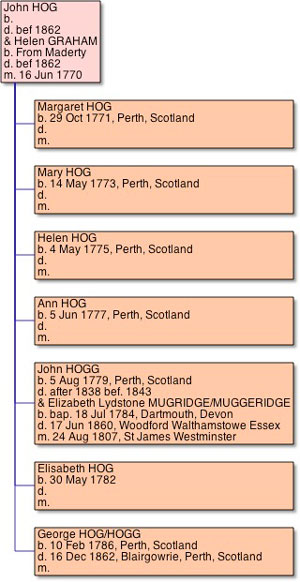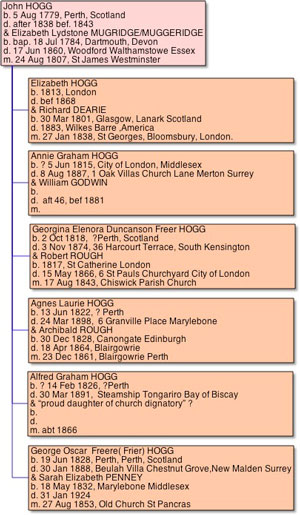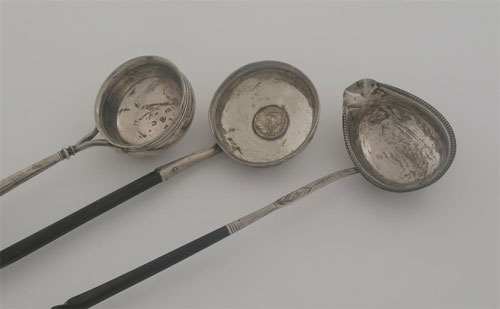
For the descendents of Richard Dearie and his son John Russell
John Hog or Hogg
5 August 1779 to
15 January 1839 (1)
Jeweller and Goldsmith
Complied by Claire Grey
John's daughter Agnes Rough wrote in her notebook "my dear father John Hogg’s Birthday July 5", but we have no other documentary evidence to support this.
John Hogg's father was also called John and was a weaver. John's mother was Helen Graham, from the parish of Madderty. His parents had married at the Church of Scotland Parish Church on 29 June 1770 in Perth.
John was the 5th of 7 children all of whom were born in Perth.


John's career
According to research by Robin Rodger and Fiona Slattery, at the Perth Museum, John Hogg was the “first of five recorded apprentices of James Cornfute for five years commencing 25.8.1794 and the only one to become a freeman himself. He completed his apprenticeship under William Ritchie in August 1799.“ (2) He would have been 20 in 1799.
He married Elizabeth Lydstone Muggeridge from Devon, in London on 24 August 1807 when he was 28.
They married at St. James Westminster, a church designed by Sir Christopher Wren and a very fashionable and famous place to be married in. The witnesses were Benjn. Bright and B. Scott. Both bride and groom were described as “of this parish”. The curate was Charles Spencer. There is no address.
They seem to have lived in the city for the birth of their first two children, Elizabeth in 1813, and Annie in 1815. Further searches could be done in Hatton Garden, the jewellers' district of London.
"Following ( his master) Ritchie’s death in 1815 Hogg succeeded to his premises. Produced an assay of a gold ring 7.10.1815. Admitted Freeman Goldsmith and Jeweller 23.10.1815 Sent silver for assay 1815. He had Ritchie’s last two apprentices, Alexander Stewart and Daniel Robertson, transferred to him in 1815. He gave up his mastership of one of these men in 1817".(3)
John's four youngest children appear to have been born in Perth according to family records and the census: Georgina in 1818, Agnes in 1822, Alfred 1826 and lastly Oscar in 1828 when John's wife Elizabeth was 44.
The family myth recorded his death on the same day as his wife's father. Gertrude Fox's noted on the back of John's wife's picture: “ same time Gr. mother M’s husband James (sic) Hogg died asleep with folded arms. Traveling in Scotland, but wife woke same night, heard him returning home and rose to open to him Tho’ in perfect health the night he died, on retiring to rest he begged, if anything happened he should be buried with a piece of bread he carried. “It was the last I broke with my wife”
His death turns out to be more prosaic as is recorded in Robin Rodger's and Fiona Slattery's research:" Recommended as an Infirmary Patient 27.9 1838. Meeting of the Hammermen was informed that Hogg was ' in indigent circumstances and labouring under a violent disease'.(4) He was admitted at the Hammermen’s expense to Perth Infirmary. He died suddenly on the morning of 15 January 1839 ' in destitute circumstances'"(5)
The fact that John became a "freeman" presumably means he became a member of the Company of Hammermen, but has been recorded in family myth as his being given the "Freedom" of the City of Perth. It is possible that his death story was made up to comfort his children or it may have skipped a generation and belong to his father?
His wife and children moved to Turnham Green in London and and can be found there on the 1841 census running a school.

When interviewed in 1985 some members of the family said that his jewellery was worn until recently.
George Hogg.
John Hogg’s brother George was also a jeweller and remained single all his life. He appears to have been active between 1837 and 1845.
The earliest street directory for Perth shows that he had a shop in Perth at 238, High Street in 1837. It is possible that he took over the business when his brother became ill? The directories show that in 1843 the shop was at 148, South Street, Perth and the 1848- 1849 directory is the last one in which his name appears.
George Hogg can be found living with his brother’s family in Hammersmith on the 1851 census. The census reveals that he was still a jeweller aged 65 and also deaf.
Ten years later George can be found on the Scottish census in 1861 aged 76 living with his niece Agnes aged 38 at 4 Union Bank, Blairgowrie. He appears to be retired.
Union Bank was in the centre of Blairgowrie and their next door neighbours at Number 3 are called Soutar. He lived to see Agnes' marriage on 23 December 1861 in Blairgowrie and the birth of her son Archie on 1 November 1862.
George Hogg died on 16 December 1862 aged 76.
More research will need to be done to go farther back but given the unusual names of these children: including Duncanson, Freer and Lawrie it should be possible to do so.



The punch ladle in the centre right is by John Hogg.
It was for sale in October 2007, on the Woolley and Cornwallis web site. Photo used with their permission.
They describe it as: "a George III Scottish provincial example with a twisted whalebone handle and a coin inset bowl, initialed "D E Mc", by John Hogg, Perth (IH, eagle) c.1815."
The Perth Museum has two examples of his work, a teaspoon and a toddy ladle. Record Numbers:12G/1946 and 12G/1946

Notes.(1)(2) (3)and (5)
No records could be found of John Hogg's death on the Scotland's people website, although it was known to be between 1838, the date of his daughter Elizabeth’s wedding and 1843, the date of daughter Georgina’s wedding. His death date along with the other details of John Hogg's career comes from "Perth Silver, A Guide to Perth Silver and Silversmiths and illustrated by the collections of Perth Museum and Art Gallery", by Robin H. Rodger and Fiona Slattery Published by Perth Museum and Art Gallery 2001. I am very grateful for the help of Sandra Martin, Art Officer at the Perth Museum and Art Gallery, who in June 2010 , took time to send me this information, and for being allowed to quote from it.
The Perth Museum and Art Gallery George Street, Perth, PH1 5LB, Telephone: 01738 632488: " There is a particularly strong collection of Perth Silver with domestic, ecclesiastical and ceremonial ware from the 17th to the 20th century. Much of this is on display.
"Perth was the effective capital of Scotland in the 12th century and the history of gold and silversmithing goes back to this time. Their trade declined from 1836 because an act was brought in requiring all Scottish silver to be hall marked in the Assay Offices of Glasgow and Edinburgh. This meant all future production was concentrated in these cities. From the 1850s the new cheaper process of electro- plating of silver became more widespread and supplied the needs of the less expensive market."
(4) indigent : destitute: poor enough to need help from others
(6) Images from the www.silvercollection.it © web site. With thanks to Giorgio Busetto for permission to use them.
John Hogg's hall marks are shown left.(6)
The top one includes a pot of lilies twice. The hall mark for Perth was a double headed eagle. A more distinct 1830 version of the eagle is shown left.
John Hogg is in the burial register for Greyfriars Cemetery in Perth. The entry lists his occupation as a silversmith and that he died aged 59 on the 15th January 1839. He was buried on 17th January 1839. The cause of death is listed as "heart cramp". Unfortunately the entry does not give a lair number.
Thanks to John Watson, a work experience student at Perth and Kinross Council Archive, who found this entry in June 2010.
Perth burial records can be found online here.
